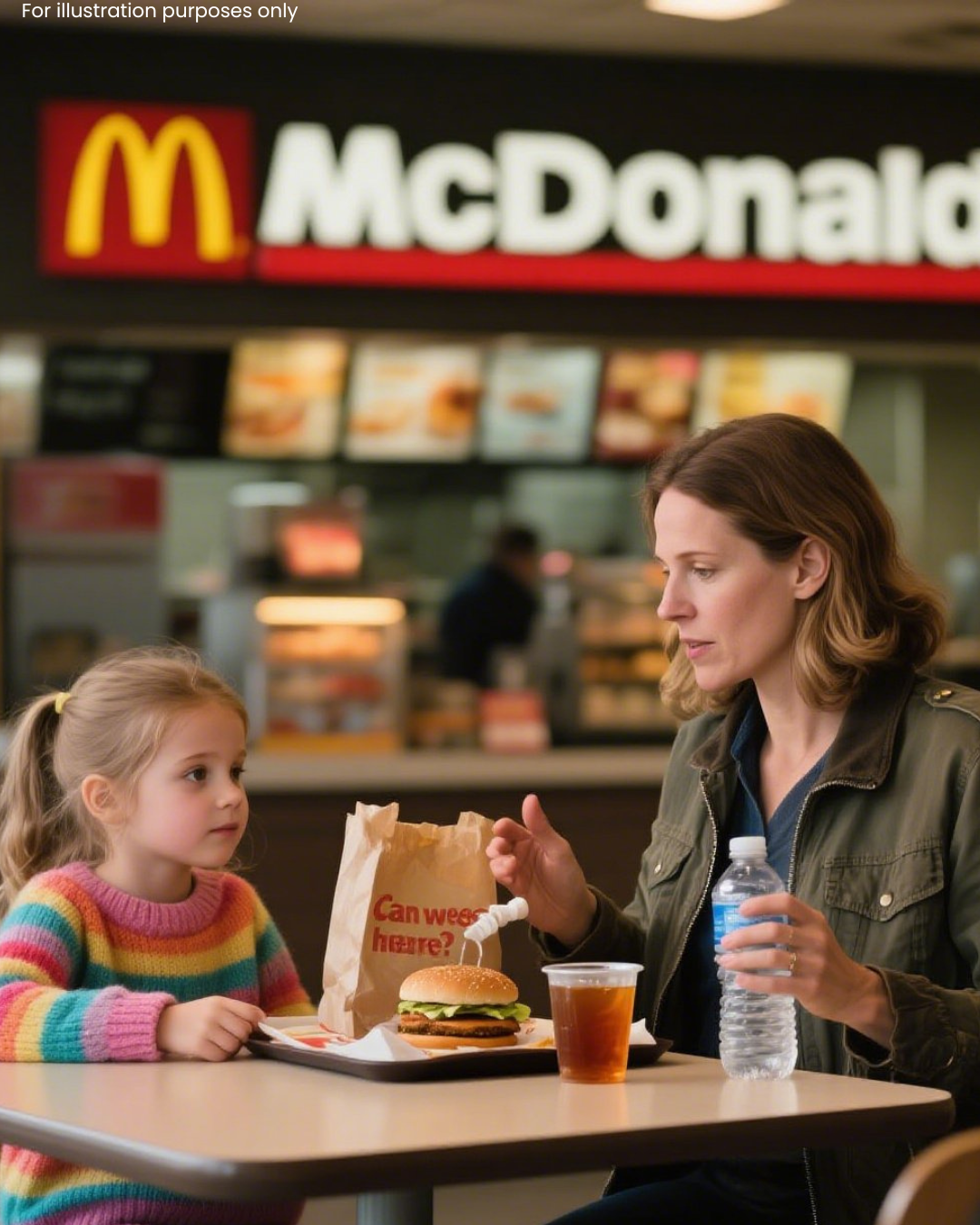The girl quietly asked, “Can we eat here, please?”
They bought a single hamburger and sat at the table next to mine. Then, the mom took out a thermos from her bag and poured what looked like tea for her daughter.
As I listened, I pieced together parts of their story. They had just come from the hospital, and the mom had saved just enough money for the bus ride home. Whatever was left went towards that one hamburger, because it was the first time her daughter had ever been to McDonald’s.
After finishing my coffee, I walked back to the counter and bought a Happy Meal. I placed it on their table and left before they could say anything.

But I’ll never forget the gratitude in the mother’s eyes and the bright smile on that little girl’s face.
Sometimes, even the smallest act of kindness can mean everything.
As I stepped outside into the evening air, I felt my heart a little fuller. That little girl’s face stayed with me. It reminded me how much joy kids find in the simplest things—one hamburger, one cup of tea, one moment shared with someone they love. They didn’t have much, but their gratitude for what they did have was clear.
That night, I replayed the scene in my mind. The mother’s tired eyes, a mix of worry and relief, and the pure joy on her daughter’s face. Their gratitude had stayed with me so much that I had trouble sleeping. I wondered about their story—who was in the hospital? Why were they there so often? Were they alone?
A week passed, and every time I passed a McDonald’s, I thought about that small moment of kindness. I figured I’d never see them again, but a part of me hoped I might cross paths with them one day.
Two weeks later, on a rainy Tuesday morning, I got on my usual bus to work. I had my earbuds in, mindlessly scrolling through my phone, when I saw a familiar little face peeking over the seat. It was the same girl from McDonald’s, with that sweet smile. Her hair was neatly braided, and she was holding the same thermos her mom had used.
I took out my earbuds and leaned forward. “Hey there,” I said quietly. The girl blinked, a little shy, and I waved to her mom. The mother instantly recognized me. Her eyes widened for a second before she smiled.
“You’re the kind person from McDonald’s!” she said, both surprised and relieved.
I smiled back. “It’s so good to see you both again. How are you?”

She introduced herself as Carla, and her daughter as Lani. We chatted quietly during the bus ride. It turned out they were heading to a different hospital, one with specialists for Carla. She explained that she had a chronic heart condition, which made it difficult to work full-time. Money was tight. That day, she had been at the hospital to sign up for a new medication program. Insurance had been giving her trouble, and Lani was just happy to be with her.
Hearing Carla’s story put things into perspective for me. I sometimes complained about my commute or work, but Carla was dealing with a chronic illness while caring for her little girl. And yet, she was so positive. She said, “I’m just glad we have each other.”
When the bus reached my stop, I waved and said, “If you ever need anything, please reach out.” I wrote my number on a piece of paper and handed it to Carla, not expecting anything but wanting her to know someone cared.
That evening, I felt moved and decided to share a brief story about that day at McDonald’s on social media. Without revealing any personal details, I spoke about how it made me realize the power of small gestures. I encouraged people to look out for each other whenever they could.
To my surprise, the post went viral. People shared their own stories of kindness—paying for groceries, babysitting for free, or lending money. The stories were uplifting and reminded me that despite the bad news we hear, acts of kindness still ripple out into the world.
A month later, I received a text from an unknown number. “Hi, this is Carla. Sorry to bother you, but I have an interview next week and could really use some help with bus fare.” My heart skipped. She had reached out.
Carla had a lead on a part-time job at a community center, and she needed a little help covering transportation for the interview. I was happy to assist. I transferred the money to cover her bus fare and a snack for Lani.
A few days later, I found myself standing outside the community center, hoping the interview went well. I didn’t want Carla to feel pressured, so I told her I was just running errands nearby, but really, I just wanted to be there in case she needed anything.
When Carla came out, her face was glowing. “I got the job!” she said, hugging Lani, who was jumping for joy. Carla turned to me, eyes filled with tears, and said, “Thank you… not just for the bus fare, but for seeing us and caring.”

I felt a mix of relief, joy, and hope. The job wasn’t a cure-all, but it was a big step forward—flexible hours, insurance to help with her medications, and a sense of stability. That moment reminded me how sometimes, all someone needs is a little support to get them on the right track.
Over the next few months, Carla and I stayed in touch. She’d text about Lani’s schoolwork or her new medications, and slowly, things started to improve for her. With her health more manageable and the new job, Carla’s life began to shift. She still radiated the same warmth and gratitude I had seen at McDonald’s, no matter what came her way.
One afternoon, Carla surprised me with a small gift card and a handwritten note. She insisted on “paying me back” for my kindness, even though I told her she didn’t need to. She said she wanted to teach Lani the importance of giving back. That touched me deeply. Not only had Carla found her footing, but she was also passing on the lesson of kindness to her daughter.
Looking back, I still remember that moment at McDonald’s—the day a mother and daughter shared a simple meal. If I hadn’t paid attention, I might have missed a chance to offer hope. In return, they gave me a deeper sense of purpose, reminding me of our shared humanity.
If there’s one thing I’ve learned, it’s that when we open our eyes and hearts, we can turn an ordinary day into something meaningful. A small gesture can ripple out in ways we never expect.
In a world that can feel overwhelming, don’t underestimate the power of a simple act of kindness. You never know how far it will go.
Thanks for reading. I hope this story reminds you that kindness is universal—and each of us can brighten someone else’s day. Please share this if it resonates with you, and let’s keep the ripple of kindness going.


